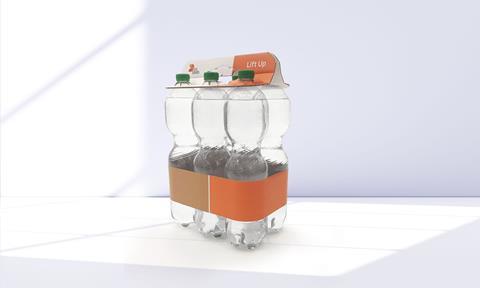On the occasion of the opening of DS Smith’s R8 innovation centre near Birmingham in the UK, Elisabeth Skoda spoke to Marc Chiron, Global Sales, Marketing & Innovation Director for the packaging division at the company, about changes and developments in the cardboard packaging industry.

Elisabeth Skoda: You’ve worked with DS Smith for over 15 years. What changes have you seen in the cardboard packaging industry, and how has the focus of packaging and consumer demand shifted over the years?
Marc Chiron: There have been massive changes. The competition landscape has changed dramatically, with several consolidations, some of which DS Smith has been an actor in. Technology also has changed a lot, which has brought opportunities.
There are a lot of changes in the consumer and customer landscape. Consumers are more volatile than they used to be, which results in less brand loyalty. Our customers have to reach out to them through different channels, which creates a challenge for them, and complexity in the supply chain. This complexity has to be managed.
I believe that with our solutions we have a role to play to support opportunities as we are there across nearly the whole value chain.
In e-commerce, we started out with big boxes that weren’t optimised, transporting a lot of air, but this has improved a lot in recent years. Furthermore, e-commerce has boomed during the COVID-19 years, and volumes still remain high.
15 years ago, functionality, print quality and the design itself were big topics. Of course, that focus is still there, but the scope of discussion with customers is wider now, it’s about efficiency across the entire supply chain, and of course, the big topic of sustainability, including CO2 emissions and circularity.
Plastic substitution has also been high on the agenda for a few years. In addition to that, we are getting closer to the consumer with our primary packs such as DS Smith Easy Bowl. This creates challenges, but also a lot of opportunities, and we are committed to taking them.
ES: I’d like to zoom in on the sustainability challenges the packaging industry faces. What strategies does DS Smith use to address them?
MC: One big challenge is to reduce our Scope 1 and Scope 2 emissions. A big chunk of our carbon footprint is in our paper mills. We have several programmes to optimise them with renewable energy, greener logistics, and more efficient machines. Our commitment is to be carbon neutral by 2050, and we want to reduce our carbon footprint by 46% by 2030.
We also bring our suppliers on board as they are part of our Scope 3 emissions, and we need to make sure that we can support them. The big challenge and opportunity here is to help our customers tackle their own commitment to sustainability and circularity. We start with design and put our circular design metrics in place. Now we have a tool to trigger different types of discussions to find a good compromise. There is no silver bullet to increase the circularity or the sustainability of a product, it’s all about compromise.
With the circular design metrics, we’re in a position to trigger the right discussion, for example about the design of a box to avoid transporting air, and maybe move to other types of packaging, such as paper bags or envelopes.
A lot of thought also goes into value chain integration. This is where more radical innovation comes into play, and where we want to challenge ourselves together with our customers.

For example, DS Smith Lift Up, developed in collaboration with Krones, is a 100% recyclable corrugated handle that improves carry functionality for consumers and is an alternative to shrink-wrapped multi packs. Developing a solution such as this, addressing both sustainability and efficiency challenges can take years.
We try to optimise what we do at the core, but we try to go beyond the traditional boundaries of our industry to explore new territories and solutions. It’s not just about the solution, it’s about the service. Data plays a key role here. The more knowledge we have from the supply chain, the better our position is to understand where we can contribute to fine-tuning solutions to optimise the fibre and the design. There are plenty of things we don’t know yet, so we have to work on understanding it better.
We need to understand our customers’ pain points better. It’s not just about receiving a brief and creating the solution, it’s about understanding where they are struggling, and where the opportunities are to deliver the efficiencies that are needed in the supply chain while at the same time coming up with something different.
Being proactive about innovation is the only way forward. We take a certain level of risk, which means things may take longer. You need to learn to fail and bounce back quickly. This cannot be done alone - I strongly believe that to crack the big circularity challenges, we have to build an ecosystem.
ES: What are other key topics that are relevant today?
MC: Beyond sustainability, another relevant topic which came back strongly in recent years is resilience in the supply chain, which is particularly relevant after what we experienced with COVID-19 and the war in Ukraine. It’s important to be able to support customers locally with scalable solutions.
Efficiency is also important. Our customers need to manage a lot of complexity, and different routes to market, from e-commerce to smaller convenience stores, hypermarkets, discounters and more. Beyond FMCG, in the industrial markets, they also have to ensure that they can produce closer to their core factories as they’ve been exposed to a lot of disruption in recent years. We need to make sure that we are there to support customers with their resilience and efficiency and solutions across the globe. There’s an appetite for us to manage more of the complexity on their behalf. So that’s where DS Smith is moving from solution to service.
ES: Is there a typical process for collaboration with a customer, and is the new R8 facility going to enhance the solution?
MC: There’s no one way to collaborate with customers. But to crack something big, the first step is to allocate time from both sides and allocate the right resources to talk about circularity, digitalisation and having the right talent in the organisation. We need to dig into the pain points, engaging with a lot of different stakeholders in the customer organisation. Traditionally that’s R&D and procurement, but we also need to go into the supply chain. We need to co-create with our customers and their partners, which happened with DS Smith Lift Up or Nano, for example. That’s why it takes a lot of time. We need to look at a challenge from different angles and find a compromise to make sure it’s fit for purpose and delivers value for the final consumer. The R8 facility will help.
With the example of Nano, we have a place where we can meet around the prototype and the pilot line with our customers, their partners and our partners and spend time together. So, it’s a safe place to get things right. We create a bubble for people to create something great. We can perform tests in the laboratory, and make sure that we test validate the promise we give to our customers. We have a lot of start-up partners as well. It’s a great opportunity to open our minds to better understand the impact of our solution on the customers’ supply chain. We as an organisation have to be ready to take risks and get results, and we are committed. It can’t be achieved in six months, but you need to take time to develop solutions with the right experts, and this is why we are so excited about the new research facility.
ES: I’d like to look towards the future – where do you see the industry going, and, more specifically, what innovations do you expect to come out of the new R8 facility?
MC: I’m convinced that we will move to a world where service will have a clear role to play. We will have to better understand the supply chain, and understand how we can play a role for our customers. Data will become more and more important. But it’s not only about the fancy digital platform. It’s about capturing the right data in the right place and then, with the help of AI, making something out of this data and extracting the benefit for the specific point in the value chain.
Here we have plenty of room for innovation. Even though our industry could sometimes be perceived as a bit traditional, I think the scope of the innovation in front of us is enormous. We need to go beyond what we used to do traditionally, so we need to build on the strengths we have. I think we are, as an industry, circular by nature. But how do we bring that into the world of our customers, how can we help them to become more circular?
The other topic that will be high on the agenda is reuse. This is an interesting and complex one to crack, easier for the B2B supply chain than B2C supply chain. But we definitely have a role to play. A reuse data service would be something to consider for the future.
It’s exciting to see how the industry has grown and changed. 15 years ago, when we said to the world that DS Smith’s products were recyclable by nature, there wasn’t a lot of interest. The world has changed, and sustainability is at the heart of all the conversations we have with our clients. This is great, but also gives us more responsibility. We need to go beyond what we used to do, and not be afraid to explore new territories, and we are committed to doing that. Our R8 facility is proof of this commitment.
If you liked this article, you might also enjoy:
The L’Oréal approach to packaging sustainability
What steps is Apple taking to make its packaging more sustainable?
How did Brazil achieve its 100% aluminium can recycling rate – and can it be replicated in the EU?
Experts have their say on the EU’s Packaging and Packaging Waste Directive revisions
















No comments yet